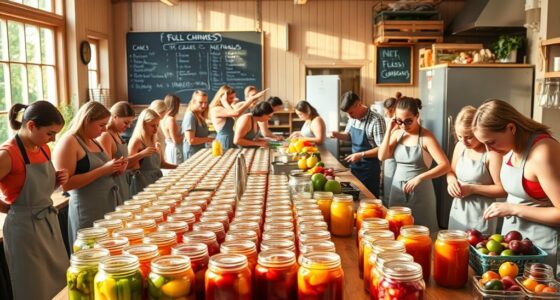To preserve food without refrigeration, use techniques like drying or dehydration to remove moisture, which stops bacteria growth. Salt and curing methods, such as dry or wet curing, prevent spoilage when done correctly. Fermentation enhances flavor and adds beneficial probiotics. Canning in sterilized jars, smoking with flavored woods, and adding acidic solutions like vinegar also extend shelf life. Maintaining proper storage conditions, such as cool, dark, breathable spaces, helps keep your food safe longer. Explore more to master these methods.
Key Takeaways
- Use drying, dehydration, or sun-drying to remove moisture and inhibit bacterial growth.
- Apply salting, curing, or acidic solutions like vinegar to preserve and prevent spoilage.
- Store canned or jar-preserved foods in cool, dark, and dry places to extend shelf life.
- Incorporate smoking techniques with proper wood and temperature control to add flavor and inhibit bacteria.
- Ensure proper storage in airtight, breathable containers and regularly inspect for spoilage signs.
Drying and Dehydration Methods
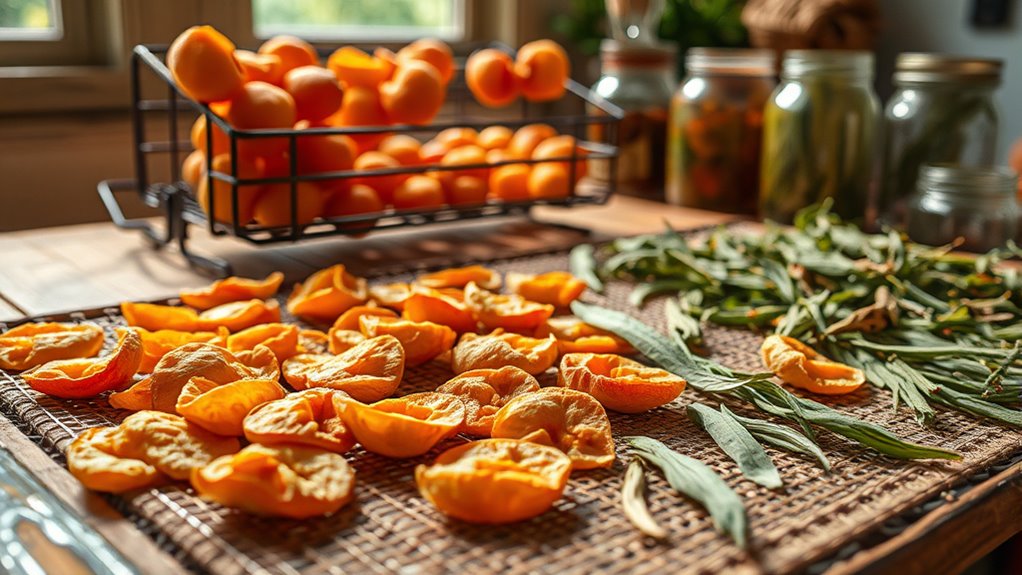
Drying and dehydration are among the simplest and most effective ways to preserve food without refrigeration. By removing moisture, you inhibit the growth of bacteria, yeasts, and molds that cause spoilage. As you dry food, its texture changes, becoming lighter and more brittle, which makes storage easier. You can use sun drying, air drying, or specialized dehydrators to achieve the desired moisture removal. Confirm you slice fruits or vegetables evenly for uniform drying, and keep them in a clean, dry environment. Proper drying not only extends shelf life but also enhances flavor concentration. Keep in mind that over-drying can make food too hard, while under-drying leaves residual moisture, risking spoilage. This method is simple, cost-effective, and preserves food’s natural qualities. Additionally, understanding proper storage techniques can help maintain dried foods’ quality over time. Ensuring proper temperature and humidity control during storage further prolongs their freshness and safety. Incorporating appropriate packaging methods can also protect dried foods from moisture and pests.
Salting and Curing Techniques

You need to understand how salt concentration and timing affect the preservation process, as they determine how effectively bacteria are halted. Different curing methods, like dry curing or brining, offer various advantages depending on the food and desired outcome. Choosing the right technique guarantees your preserved food stays safe and flavorful without refrigeration.
Salt Concentration and Timing
Achieving proper preservation through salting and curing requires careful attention to salt concentration and timing. You must adjust the brine concentration to ensure it’s salty enough to inhibit bacteria without ruining the flavor. Precise timing is essential; leaving food in the cure too long can lead to over-salting, while too short a period might not preserve it effectively. Monitor your curing process closely, and use a timer to maintain timing precision. Here’s a quick guide:
| Brine Concentration | Curing Time |
|---|---|
| 10-15% salt | 1-3 days (thin cuts) |
| 20-25% salt | 1-2 weeks (thicker cuts) |
Additionally, maintaining consistent salt levels throughout the process helps optimize preservation and flavor. Proper food safety practices are crucial to prevent spoilage during curing.
Types of Curing Methods
There are several curing methods you can use to preserve food without refrigeration, each leveraging different techniques to inhibit bacterial growth. Curing techniques vary, but common methods include dry curing, wet curing, and smoking. Dry curing involves rubbing salt or a salt-based mixture directly onto the food, drawing out moisture and creating an inhospitable environment for bacteria. Wet curing, or brining, submerges food in a saltwater solution, enhancing preservation and adding unique flavors. Smoking adds a layer of flavor while also dehydrating the food, further preventing spoilage. These curing methods not only extend shelf life but also influence preservation flavors, offering a range of taste profiles from salty to smoky. Choosing the right technique depends on the food type and desired flavor outcome. Additionally, understanding the key traits of successful preservers can help ensure safe and effective food preservation, especially considering the power of dehydration and smoke in extending food shelf life. Proper application of these methods can also reflect traditional practices rooted in historical food preservation techniques, emphasizing their enduring importance.
Fermentation Processes and Benefits
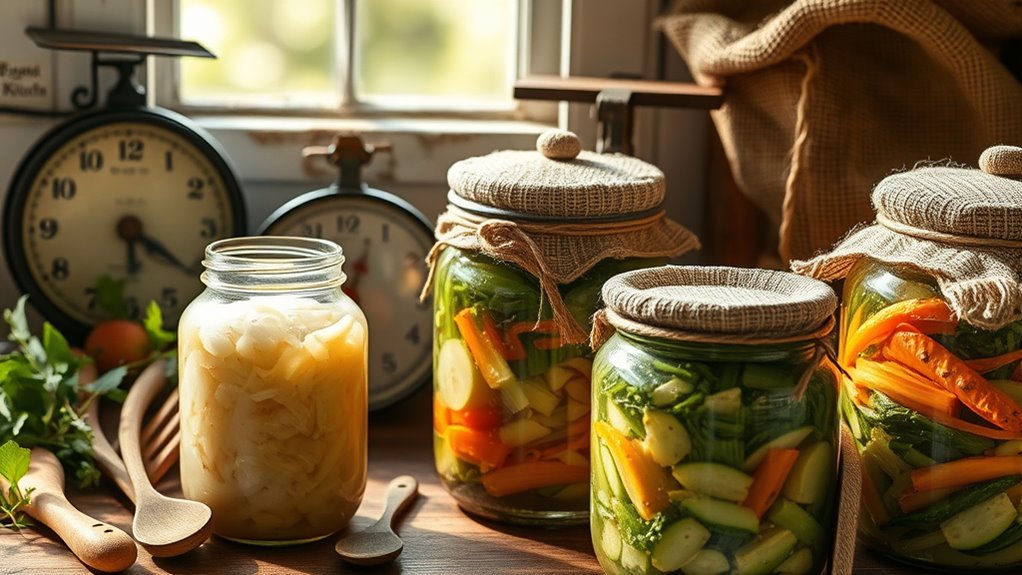
Fermentation is a natural process that transforms raw ingredients into preserved foods with enhanced flavor and safety. By encouraging beneficial bacteria to grow, fermentation offers numerous benefits, including improved digestion and increased nutrient availability. The fermentation benefits extend beyond preservation; it produces probiotics that support gut health and boost your immune system. When you ferment vegetables, dairy, or grains, you create foods rich in live cultures, making them a wholesome addition to your diet. Plus, fermentation can intensify flavors, adding tangy, complex notes to your preserved foods. This process is simple, cost-effective, and relies on natural enzymes and bacteria, eliminating the need for artificial preservatives. Additionally, understanding the core traits of different personality types can help tailor your approach to food preservation and share techniques more effectively with others. Incorporating nutritional advantages such as high vitamin and antioxidant content can further enhance the health benefits of fermented foods. Engaging in fermentation also promotes food safety by reducing harmful bacteria and molds, ensuring your preserved foods remain safe to consume. Exploring mindful practices during fermentation can help maintain proper conditions and improve your end results. Embracing fermentation allows you to enjoy safe, nutritious, and flavorful foods without refrigeration.
Canning and Jar Preservation

Canning and jar preservation provide effective ways to extend the shelf life of seasonal fruits and vegetables without refrigeration. To start, you’ll need clean, sterilized jars—jar sterilization is essential to prevent spoilage. Next, prepare your produce with pickling spices to enhance flavor and guarantee safety. When filling jars, leave proper headspace to allow for expansion. Seal jars tightly and process them in a boiling water bath or pressure canner, depending on the food type. This method kills bacteria and creates a vacuum seal, keeping contents safe for months. Proper temperature control during processing is crucial to ensure safety and quality. Be sure to check seals before storing. With these steps, you can enjoy your harvest long after the season ends, preserving freshness and flavor naturally.
Smoking as a Preservation Strategy
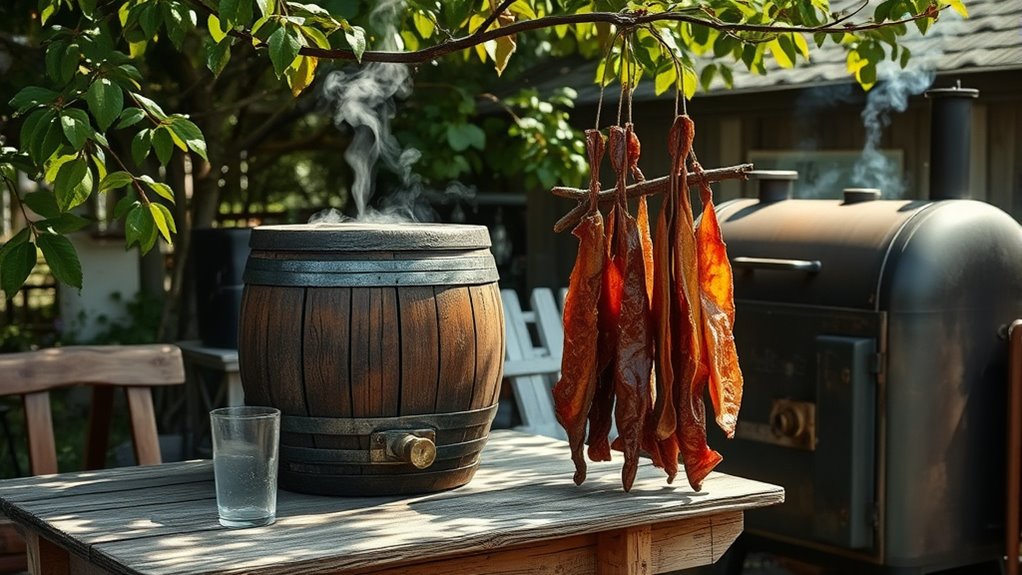
Smoking uses different methods like hot, cold, and smoke curing to preserve food, so you can choose the best for your needs. Picking the right wood, such as hickory or apple, adds flavor and helps with preservation. Remember to follow safety tips and store smoked foods properly to keep them fresh and safe. Incorporating proper storage techniques can further extend the shelf life of smoked foods and ensure their safety. Additionally, controlling the smoke exposure during curing can enhance flavor and prevent spoilage, especially when combined with AI-powered monitoring to optimize the process. Understanding the types of wood used for smoking can also influence both flavor and preservation quality.
Types of Smoking Methods
Different smoking methods play a crucial role in preserving food without refrigeration by enhancing flavor and inhibiting bacterial growth. You can choose from several techniques based on smoking temperature and wood flavor.
- Hot Smoking: Conducted at high temperatures (around 165-185°F), this method cooks and preserves food simultaneously, imparting a rich wood flavor.
- Cold Smoking: Performed at lower temperatures (around 68-86°F), it preserves food without cooking, relying on extended smoking sessions to build flavor and inhibit bacteria.
- Smoke Roasting: Combines the benefits of hot smoking with roasting, using moderate temperatures for a balanced flavor and preservation.
Each method depends on controlling smoking temperature to achieve the desired flavor and preservation level, emphasizing the importance of wood flavor in the process. Additionally, selecting the appropriate Vetted electric bike conversion kit can improve transportation options for sourcing and delivering preserved foods efficiently.
Choosing the Right Wood
Choosing the right wood is vital when using smoking as a preservation strategy because it directly influences the flavor and effectiveness of the process. Your wood selection should prioritize hardwoods like oak, hickory, or fruit woods, which burn steadily and produce the necessary smoke without overpowering the food. Proper seasoning techniques are essential; avoid using green or wet wood, as moisture hampers smoke production and can create unwanted flavors. Instead, guarantee your wood is well-dried and seasoned for at least six months to maximize burn efficiency and smoke quality. Select wood types based on the food you’re preserving—mild woods for delicate items, stronger woods for more robust flavors. Seasoned wood ensures better combustion and cleaner smoke, which is crucial for safe preservation. Careful wood choice enhances preservation and adds a natural, smoky taste without introducing harmful chemicals. Utilizing self-watering plant pots can help maintain proper humidity levels during the smoking process, ensuring consistent results. Additionally, choosing the appropriate smoking temperature is critical to prevent spoilage and ensure effective preservation.
Safety and Storage Tips
To guarantee safe and effective preservation through smoking, you must pay close attention to proper safety and storage practices. Smoking slows microbial growth, but improper handling can lead to food spoilage. Here are key tips:
- Store smoked foods in a cool, dry place away from direct sunlight to prevent mold and bacteria growth.
- Use airtight containers or vacuum-sealed bags to limit exposure to air and moisture, which can accelerate food spoilage.
- Regularly check stored smoked foods for signs of spoilage, such as off-odors or sliminess, and discard if unsure.
- Incorporating proper storage practices enhances the longevity and safety of smoked foods.
- Understanding sound healing science can provide insights into natural preservation methods that complement traditional techniques.
- Utilizing digital platforms to monitor storage conditions or gather preservation tips can further improve outcomes.
- Paying attention to food safety guidelines is essential to prevent contamination and ensure the preservation process remains effective.
Using Acidic Solutions for Preservation
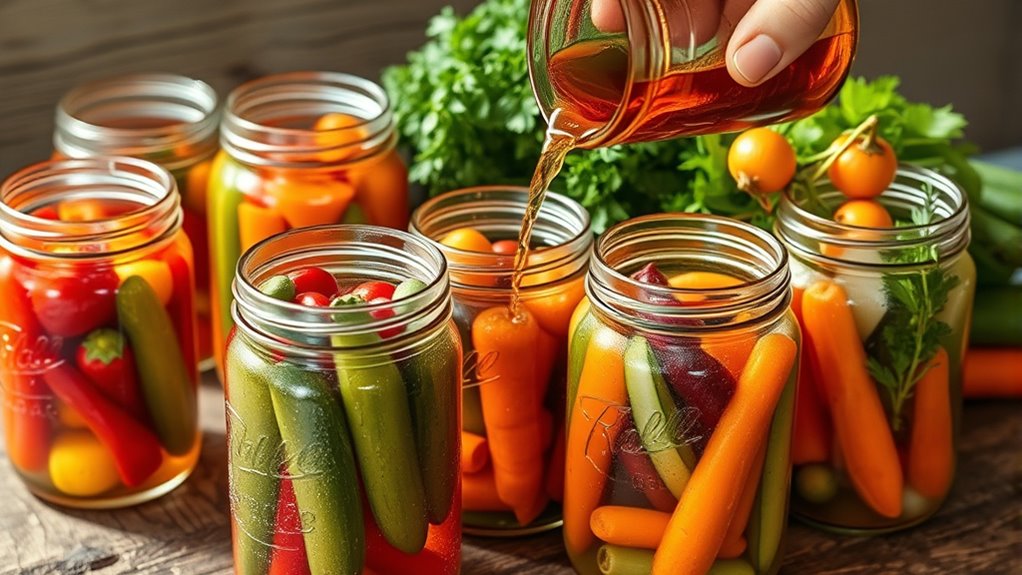
Using acidic solutions is an effective way to preserve food without refrigeration because many bacteria and molds cannot survive in low pH environments. To do this effectively, you need to focus on pH adjustment, ensuring the acidity level is high enough to inhibit microbial growth. Vinegar application is a common method, as it’s easy to add to fruits, vegetables, or preserves. When using vinegar, aim for a pH below 4.0 for ideal preservation. You can also experiment with other acidic solutions like citrus juice or citric acid. Properly balancing acidity not only extends shelf life but also enhances flavor. Remember, thorough mixing and consistent application are key to ensuring your food remains safe and preserved without refrigeration.
Storage Conditions to Maximize Shelf Life
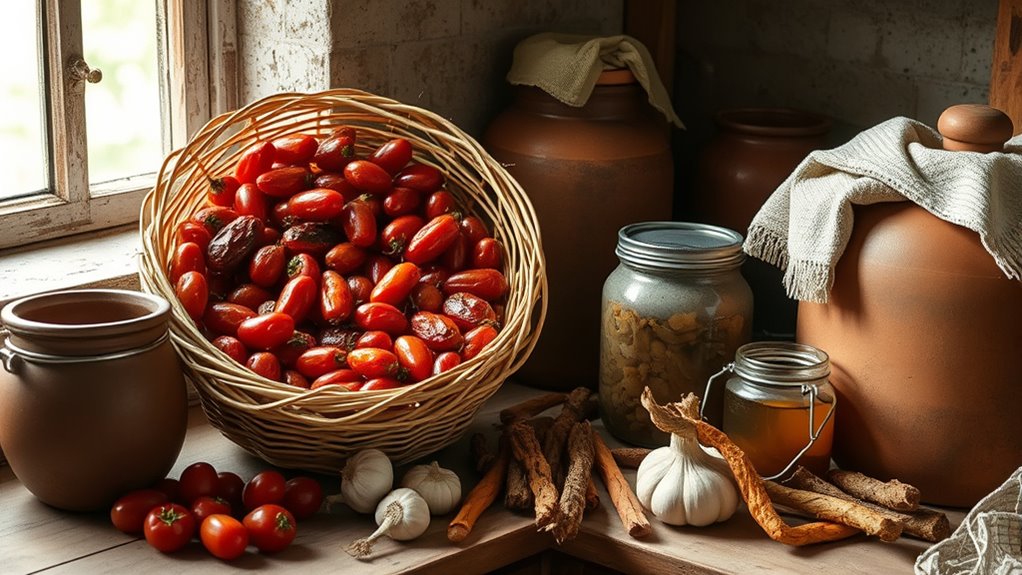
Proper storage conditions play a vital role in extending the shelf life of preserved foods without refrigeration. To do this effectively, focus on two key factors: temperature control and humidity regulation. Keeping foods in a cool, dark place slows spoilage, so aim for a consistent, low temperature. Controlling humidity prevents mold and rot; too much moisture accelerates decay.
Store preserved foods in cool, dark, well-ventilated spaces to extend shelf life without refrigeration.
Consider these tips:
- Store perishables in a cool, dry location away from sunlight.
- Use breathable containers to regulate humidity and prevent excess moisture buildup.
- Keep items off the ground and in well-ventilated spaces to maintain steady temperature and humidity levels.
Frequently Asked Questions
How Long Can Preserved Foods Stay Safe Without Refrigeration?
You wonder how long preserved foods stay safe without refrigeration. Storage duration varies depending on the method used, like canning or drying. Typically, properly preserved foods can last weeks to months, but always check spoilage indicators like off smells, mold, or changes in texture. If you notice any signs of spoilage, discard the food immediately. Regularly inspecting your preserved items guarantees they remain safe to eat and prevents foodborne illnesses.
Which Foods Are Best Suited for Dry Preservation Methods?
Did you know dried fruits and salted meats can last up to a year without refrigeration? These foods are ideal for dry preservation methods because they resist spoilage and require minimal storage space. Dried fruits retain nutrients and sweetness, while salted meats inhibit bacterial growth. By choosing these foods, you can effectively preserve your harvest and guarantee food security during emergencies or outdoor adventures.
Are There Health Risks Associated With Traditional Curing Techniques?
You should be aware that traditional curing techniques can pose health risks if not done properly. Using curing chemicals or salt can prevent foodborne pathogens, but improper handling might lead to contamination. Always follow trusted methods to minimize risks, guarantee thorough curing, and avoid excess chemicals. This helps protect you from foodborne pathogens and ensures your preserved foods remain safe to eat without refrigeration.
How Do Preservation Methods Impact Food Nutritional Value?
Ever wonder if preservation methods secretly steal nutrients from your food? The preservation impact varies—some techniques like drying or fermenting can actually boost nutrient retention, while others might cause slight nutrient loss. You might be surprised how choosing the right method helps keep your food nutritious and delicious. With careful selection, you preserve not just flavor but essential nutrients, ensuring your food remains healthy and full of life.
Can Preserved Foods Be Stored Outdoors Safely Year-Round?
Storing preserved foods outdoors year-round isn’t always safe due to seasonal variations that affect temperature and humidity. You might risk spoilage or contamination if conditions fluctuate too much. To keep your food safe, consider outdoor storage only during stable seasons with mild weather. For consistent safety, it’s better to store preserved foods indoors or in a controlled environment, especially when seasonal changes could compromise their quality or safety.
Conclusion
By mastering these timeless preservation techniques, you turn your kitchen into a treasure chest of flavors, keeping food safe like a loyal guardian. Each method is a brushstroke in your culinary masterpiece, preserving freshness and taste even when the fridge’s not an option. With a little patience and skill, you’ll craft your own pantry of gold, ready to nourish you through seasons, turning everyday ingredients into lasting treasures waiting to be uncovered.



